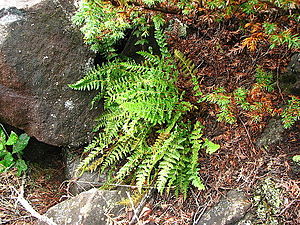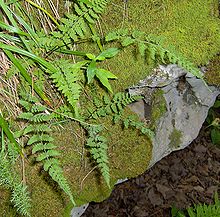Eyelash ferns
| Eyelash ferns | ||||||||||||
|---|---|---|---|---|---|---|---|---|---|---|---|---|

Rust-red eyelash fern ( Woodsia ilvensis ) |
||||||||||||
| Systematics | ||||||||||||
|
||||||||||||
| Scientific name | ||||||||||||
| Woodsia | ||||||||||||
| R.Br. |
The eyelash ferns ( Woodsia ) are a genus of plants in the family of the eyelash ferns (Woodsiaceae). The 38 or so species thrive in the temperate areas of the northern hemisphere and in the mountains of the Neotropics , tropical Africa and Madagascar .
description


Woodsia species are relatively small, perennial herbaceous plants . The rhizomes are relatively short, upright, mostly upright or ascending and provided with chaff scales. The scales are lanceolate or linear-lanceolate and membranous.
The leaves are divided into stalk and blade. The frond stem has 1/5 to 3/4 the length of the blade. It contains two vascular bundles which unite at the top with a U-shaped cross section. The blade of the frond is simple to double pinnate or pinnate to pinnate, linear, lanceolate or egg-shaped in outline. The segments have entire margins or are toothed, but without a grann tip. The relatively small sori consist of 3 to 19 asymmetrical sporangia . The sporangia lie in a row between the midrib and the edge of the segments. The veils are designed differently; they are frayed and slashed or dissolved into hair-like corners. These tips make the underside of the leaf appear hairy. The spores are ellipsoidal.
The basic chromosome number is x = 38, 39 or 41.
Systematics and distribution

The genus Woodsia was created in 1810 by Robert Brown in Prodromus Florae Novae Hollandiae , 158, Obs. 4 set up. The generic name Woodsia honors the English architect and botanist Joseph Woods (1776–1864). Woodsia ilvensis (L.) R.Br. was identified as the lectotype species in 1875. Established by John Smith in Historia Filicum , page 237. Synonyms for Woodsia R.Br. are: Acrostichum L. , Cheilanthopsis Hieron. , Eriosoriopsis (Kitag.) Ching & SH Wu , Hymenocystis C.A. Mey . , Physematium Kaulf. , Physematium Kaulf. , Protowoodsia Ching , Trichocyclus Dulac , Woodsiopsis Shmakov .
Woodsia species are found in the temperate areas of the northern hemisphere and in the mountains of the Neotropics , tropical Africa and Madagascar . There are around 20 species in China, eight of them only there.
The genus Woodsia includes about 38 species. Here is a selection:
- Alpine eyelash fern ( Woodsia alpina (Bolton) Gray , Syn .: Woodsia hyperborea (Lilj.) R.Br. ): It occurs in Europe, North America , Russia and Tibet . In Europe he comes to Spain , France , Italy , Great Britain , Sweden , Norway , Iceland , Finland , Germany , in Switzerland , in Liechtenstein , Austria , Slovenia , Hungary , the Czech Republic , Poland , Russia, in Slovakia , in Romania , in the Ukraine before.
- Woodsia andersonii (Beddome) Christian : It occurs in northern India , Nepal , Bhutan , Taiwan , Tibet and in the Chinese provinces of Gansu , Qinghai , Shaanxi and Sichuan .
- Woodsia cinnamomea Christ : This endemic thrives on rocks at altitudes of around 2800 meters only in Muli in southwest Sichuan.
- Woodsia cycloloba Hand.-Mazz. : It occurs in Sikkim , Nepal, Tibet and in the Chinese provinces of Shaanxi, Sichuan and Yunnan .
- Woodsia glabella R.Br. ex Richardson (Syn .: Woodsia alpina var. glabella (R.Br. ex Richardson) DCEaton , Woodsia hyperborea var. glabella (R.Br. ex Richardson) Watt , Woodsia lapponica Angstroms. , Woodsia yazawai Makino ): It comes in Europe , North America, Russia, Japan and China. In China, it occurs in the provinces of Gansu, Hebei , Jilin , Qinghai, Xinjiang and Yunnan. In Europe it occurs in Spain, France, Germany, Italy, Switzerland, Austria, Norway, Sweden, Finland, Russia, Svalbard and Romania.
- Woodsia guizhouensis P.S.Wang, Q.Luo & Li Bing Zhang : It was first described in 2012. It thrives in damp, shady crevices or on rock faces in the tropical karst in laurel forests at altitudes of 1600 to 2300 meters only in western Guizhou ( Bijie , Liupanshui , Pu'an ).
- Woodsia hancockii Baker (Syn .: Woodsia gracillima C.Christensen , Woodsia tsurugisanensis Makino ): It occurs in northern India, Japan, Korea, Nepal, Russia, Inner Mongolia and in the Chinese provinces of Hebei, Heilongjiang , Jilin, Shaanxi and Shanxi in front.
- Rust-red eyelash fern ( Woodsia ilvensis (L.) R.Br. , Woodsia rufidula (Michx.) LCBeck ): It occurs in Europe, North America, Kazakhstan, Russia, Mongolia , Inner Mongolia and the Chinese provinces of Hebei, Heilongjiang , Jilin and Xinjiang.
- Woodsia intermedia Tagawa (Syn .: Woodsia subintermedia Tzvelev , Woodsia taishanensis F.Z.Li & CKNi ): It occurs in Russia, Japan, Korea and in the Chinese provinces of Hebei, Heilongjiang, Henan, Jilin, Liaoning , Shandong and Shanxi.
- Woodsia lanosa Hook. (Syn .: Woodsia pellaeopsis Hand.-Mazz. ): It occurs in northern India, Bhutan , Nepal , Tibet and in the Chinese provinces of Sichuan and Yunnan.
- Woodsia macrochlaena Mett. ex Kuhn (Syn .: Woodsia frondosa Christ , Woodsia japonica Makino ): It occurs in Russia, Japan, Korea and in the Chinese provinces of Hebei, Liaoning and Shandong.
- Woodsia macrospora C.Christensen & Maxon : This endemic thrives on rock faces in mountain valleys at altitudes of 3500 to 4200 meters only in southern Gansu.
- Woodsia mexicana Fée : It occurs in northeastern Mexico .
- Woodsia neomexicana Windham : It occurs from the western and central United States to northern Mexico.
- Woodsia oblonga Ching & SHWu : It thrives in crevices of shady rocks at altitudes of 200 to 1800 meters in the Chinese provinces of Hebei, Henan and Shandong.
- Blunt-leaved ciliate fern ( Woodsia obtusa (Sw.) Torr. ): It occurs in eastern Canada and in the eastern to central United States.
- Woodsia okamotoi Tagawa : It thrives on moss-covered, shady rocks in pine forests at altitudes of 3000 to 3500 meters only in Taiwan.
- Woodsia pilosa Ching : This endemic thrives in crevices only in Songxian Henan.
- Woodsia polystichoides D.C. Eaton : It iswidespreadin the Kuril Islands , Sakhalin , Japan, Korea, Taiwan and large parts of China.
- Delicate eyelash fern ( Woodsia pulchella Bertol. , Syn .: Woodsia glabella subsp. Pulchella (Bertol.) Á.Löve & D.Löve ): It occurs in Spain, France, Germany, Italy, Austria, Switzerland, Slovenia, Romania and in Georgia before.
- Woodsia rosthorniana Diels (Syn .: Woodsia delavayi Christ , Woodsia jeholensis Nakai & Kitagawa , Woodsia lanosa var. Attenuata C.Christensen ): It occurs in Bhutan, Tibet and in the Chinese provinces of Hebei, Liaoning, Shaanxi, Sichuan and Yunnan.
- Woodsia shensiensis Ching : It thrives on rocks in forests at altitudes of 2000 to 2900 meters in Inner Mongolia and in the Chinese provinces of Shaanxi and eastern Sichuan.
- Woodsia sinica Ching : This endemic thrives in crevices only in Ningwu Shanxi.
- Woodsia subcordata Turcz. (Syn .: Woodsia conmixta Ching , Woodsia eriosora Christ , Woodsia kitadakensis Ohwi , Woodsia longifolia Tagawa , Woodsia pilosella Ruprecht , Woodsia polystichoides var. Sinuata Hook. , Woodsia sinuata (Hook.) Ching non Makino , Woodsia viridis Ching ): She comes in Russia, Japan, Korea, Mongolia, Inner Mongolia and the Chinese provinces of Hebei, Heilongjiang, Jilin, Liaoning and Shanxi.
literature
- AO Chater: Woodsia R.Br. , Pages 25-26. In: Thomas Gaskell Tutin et al .: Flora Europaea. Volume 1, 2nd edition, Cambridge University Press 1993, ISBN 0-521-41007-X .
- AR Smith, KM Pryer, E. Schuettpelz, P. Korall, H. Schneider, P. Wolff: A classification for extant ferns. In: Taxon , Volume 55, Issue 3, 2006, pp. 705-731.
- Zhongren Wang, Christopher Haufler: Cystopteris Bernhardi. Text same online as printed work , In: Wu Zheng-yi, Peter H. Raven, Deyuan Hong (Eds.): Flora of China. Volume 2-3: Cystopteridaceae. Science Press and Missouri Botanical Garden Press, Beijing and St. Louis 2013, ISBN 978-1-935641-11-7 .
- Pteridophyte Phylogeny Group: A community-derived classification for extant lycophytes and ferns. In: Journal of Systematics and Evolution , Volume 54, Issue 6, 2016, pp. 563-603.
- M. Koltzenburg: Woodsiaceae. S. 159. In: Schmeil-Fitschen. The flora of Germany and neighboring countries. 97th edition, Verlag Quelle & Meyer, Wiebelsheim, 2019, ISBN 978-3-49401-7907 .
Individual evidence
- ↑ a b c Woodsia at Tropicos.org. Missouri Botanical Garden, St. Louis, accessed March 11, 2019.
- ↑ Lotte Burkhardt: Directory of eponymous plant names. Extended Edition. Botanic Garden and Botanical Museum Berlin, Free University Berlin Berlin 2018. online.
- ↑ a b c d e Woodsia in the Germplasm Resources Information Network (GRIN), USDA , ARS , National Genetic Resources Program. National Germplasm Resources Laboratory, Beltsville, Maryland. Retrieved March 6, 2019.
- ↑ a b c d e f g h i j k l m n o p q r s t u Zhongren Wang, Christopher Haufler: Cystopteris Bernhardi. Text same online as printed work , In: Wu Zheng-yi, Peter H. Raven, Deyuan Hong (Eds.): Flora of China. Volume 2-3: Cystopteridaceae. Science Press and Missouri Botanical Garden Press, Beijing and St. Louis 2013, ISBN 978-1-935641-11-7 .
- ↑ a b c M. Christenhusz, E. von Raab-Straube (2013): Polypodiopsida. : Datasheet Woodsia In: Euro + Med Plantbase - the information resource for Euro-Mediterranean plant diversity.



